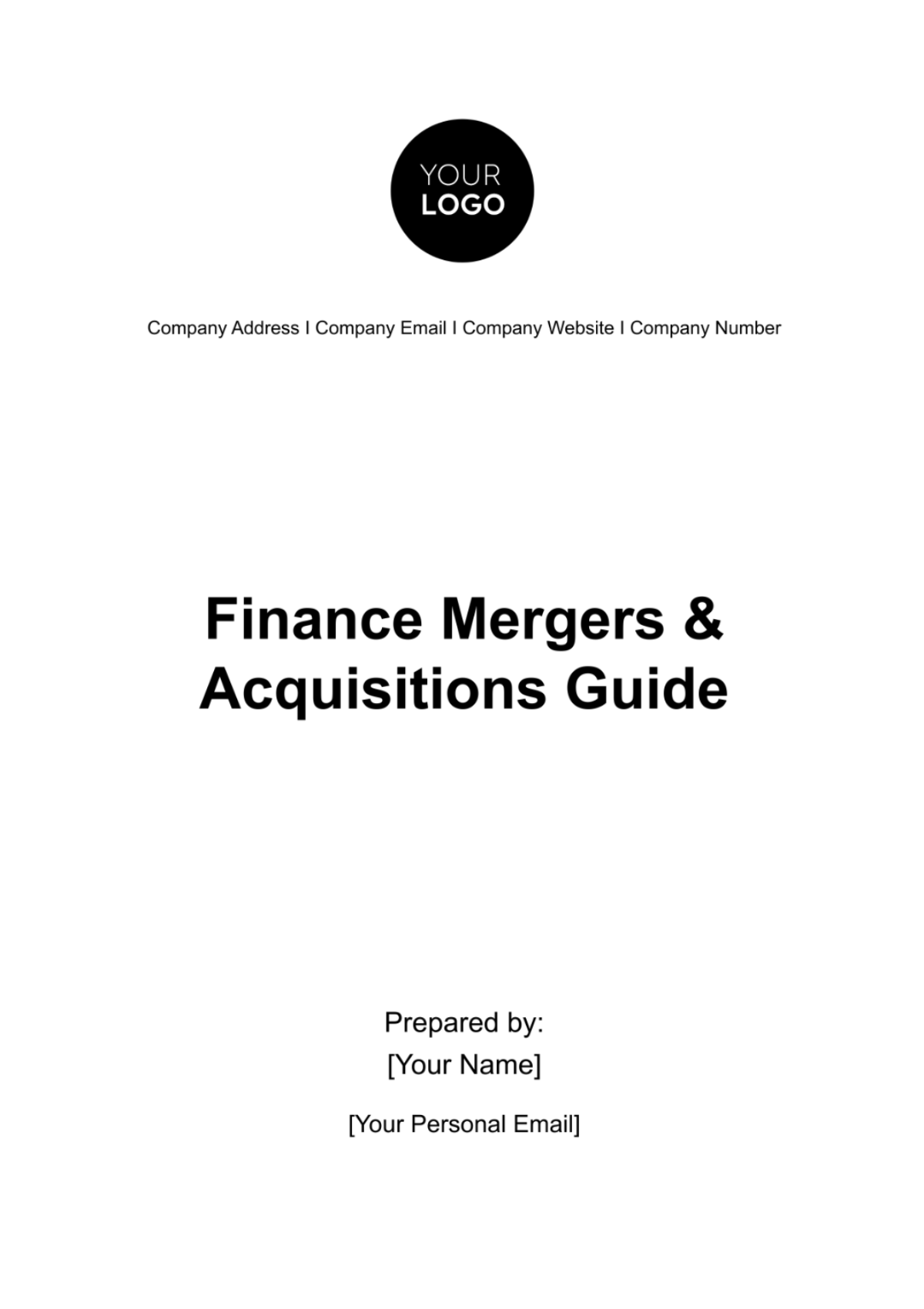Free Finance Mergers & Acquisitions Guide

TABLE OF CONTENTS
I. Introduction to Mergers & Acquisitions
II. Pre-Merger Preparation and Strategy
A. Identifying Potential Targets or Partners
B. Conducting Due Diligence
C. Valuation Techniques for M&A
D. Securing Financing and Budget Allocation
E. Risk Assessment and Mitigation Strategies
III. Legal and Regulatory Compliance
A. Understanding M&A Laws and Regulations
B. Compliance Checklist for M&A Activities
C. Navigating Cross-Border M&A Challenges
D. Role of Legal Advisors in M&A Transactions
IV. Execution of Mergers and Acquisitions
A. Negotiation Strategies and Techniques
B. Structuring the Deal
C. Integration Planning for Post-Merger Success
D. Communication Strategies with Stakeholders
V. Post-Merger Integration and Evaluation
A. Integration Plan and Execution
B. Cultural and Operational Alignment
C. Performance Metrics and Success Evaluation
D. Lessons Learned and Continuous Improvement
I. Introduction to Mergers & Acquisitions
Mergers and acquisitions (M&A) are pivotal tools for corporate restructuring, defining the landscape of modern business. Mergers involve the amalgamation of two companies to form a single entity, often seeking synergy, broader market reach, and enhanced operational efficiency. Acquisitions, on the other hand, occur when a company takes over another, potentially to access new markets, acquire unique technologies, or eliminate competition. Both strategies are instrumental in reshaping business paradigms and driving strategic growth.
Relevance to [Your Company Name]'s Business Strategy
For [Your Company Name], M&A activities are not just transactions but strategic steps towards transformative growth. They open avenues for rapid market penetration, access to cutting-edge technology, and scaling up operations, aligning perfectly with the company's vision of being a market leader. By leveraging M&A, [Your Company Name] can diversify its portfolio, reduce operational costs through economies of scale, and enhance its competitive edge, thereby positioning itself for sustainable long-term growth in an increasingly dynamic business environment.
Overview of Recent M&A Trends in the Industry
The current landscape of M&A is marked by an accelerated pace of technological innovation and evolving market dynamics. Companies are increasingly leveraging M&A for digital transformation, tapping into emerging markets, and addressing changing consumer preferences. For industries like technology, healthcare, and finance, M&A activities focus on acquiring innovative startups, consolidating market positions, and diversifying product offerings. This trend underlines the importance of strategic alliances and adaptive business models, emphasizing the need for companies to stay agile and proactive in the face of market shifts.
Goals and Expected Outcomes of M&A for [Your Company Name]
The primary goal of M&A for [Your Company Name] is to foster robust growth, expand market presence, and streamline operations. By carefully selecting and integrating complementary businesses, [Your Company Name] aims to achieve enhanced market penetration, diversification of its product and service portfolio, and operational synergies leading to cost efficiency. These strategic M&A moves are designed to fortify [Your Company Name]'s position as a leading player in the industry, driving long-term shareholder value and establishing a solid foundation for future expansion.
II. Pre-Merger Preparation and Strategy
Before venturing into mergers and acquisitions, it's crucial for [Your Company Name] to have a robust preparation and strategy phase. This includes identifying potential targets, conducting thorough due diligence, understanding various valuation techniques, securing appropriate financing, and assessing and mitigating risks. Each of these aspects plays a vital role in ensuring a successful M&A transaction.
A. Identifying Potential Targets or Partners
This subsection describes how to select appropriate M&A targets, considering factors like financial health and strategic fit.
Target Criteria | Description | Example Targets |
Financial Health | Assess the financial stability of the company, including profitability, revenue growth, and cash flow. | Company A, B, C |
Strategic Fit | Evaluate how well the target aligns with [Your Company Name]'s strategic goals and market objectives. | Company D, E |
Market Position | Consider the target's market share, customer base, and competitive positioning. | Company F, G |
Technological Assets | Examine the technological capabilities and intellectual property of the target. | Company H, I |
Cultural Compatibility | Determine the cultural alignment between [Your Company Name] and the target. | Company J |
B. Conducting Due Diligence
Here is a checklist for thorough due diligence covering financial, legal, and cultural aspects.
Due Diligence Item | Classification | Description |
Financial Statements | Financial | Review of balance sheets, income statements, cash flow statements. |
Legal Contracts | Legal | Examination of existing contracts, legal disputes, and obligations. |
Operational Systems | Operational | Assessment of the target's operational processes and systems. |
Employee and Management Structure | Organizational | Analysis of the organizational structure, key personnel, and talent. |
Market Analysis | Market | Evaluation of market trends, customer base, and competition. |
Cultural Assessment | Cultural | Understanding of the target's corporate culture and values. |
Compliance Records | Legal/Regulatory | Review of compliance with laws, regulations, and industry standards. |
C. Valuation Techniques for M&A
Discuss various methods for valuing target companies, including cash flow analysis and comparative ratios.
Technique | Benefits | Potential Outcomes |
Discounted Cash Flow | Reflects the present value of future cash flows, giving a realistic valuation. | Accurate estimation of intrinsic value. |
Comparative Ratios | Compares financial ratios to those of similar companies. | Relative valuation and market positioning. |
Asset Valuation | Focuses on the value of tangible and intangible assets. | Clear understanding of asset worth. |
Earnings Multiplier | Based on the company's current earnings and growth potential. | Projects future profitability and growth. |
Cost-to-Duplicate | Estimates the cost to replicate the target's business. | Insight into the capital needed for a similar venture. |
D. Securing Financing and Budget Allocation
Here are several strategies for funding M&A activities through loans, equity financing, or internal reserves.
Strategy | Description | Expected Outcome |
Bank Loans | Securing loans from financial institutions. | Provides immediate capital for acquisition. |
Equity Financing | Issuing new shares or selling stake in the business. | Raises funds without incurring debt. |
Internal Reserves | Utilizing existing company funds. | Avoids external financing and retains control. |
Strategic Partnerships | Collaborating with partners for joint investment. | Reduces financial burden and shares risks. |
Vendor Financing | Arranging payment terms with the target's vendors. | Eases immediate financial pressure. |
E. Risk Assessment and Mitigation Strategies
Identify potential risks in M&A transactions and presents strategies for mitigating these risks.
Risk | Mitigation Strategy | Expected Outcome |
Financial Instability | Thorough due diligence and contingency planning. | Reduces the risk of unforeseen financial issues. |
Cultural Clashes | Comprehensive cultural assessment and integration planning. | Ensures smooth cultural integration. |
Market Volatility | Ongoing market analysis and flexible strategies. | Adapts to market changes and mitigates impact. |
Regulatory Issues | Legal review and compliance checks. | Avoids legal and regulatory complications. |
Integration Challenges | Detailed integration planning and execution. | Facilitates a smooth operational merger. |
III. Legal and Regulatory Compliance
Ensuring legal and regulatory compliance is a critical aspect of M&A transactions for [Your Company Name]. This section highlights the need for a deep understanding of M&A laws, a comprehensive compliance checklist, strategies for navigating cross-border M&A challenges, and the crucial role of legal advisors in these processes.
A. Understanding M&A Laws and Regulations
This part provides an overview of legal frameworks governing M&A, including antitrust and securities regulations.
Law/Regulation | Description | Implication for M&A |
Antitrust Laws | Prevents monopolistic practices and promotes fair competition. | Ensures M&A doesn't create unfair market dominance. |
Securities Regulations | Governs the trading of company securities and disclosure requirements. | Ensures transparent and fair trading during M&A. |
Employment Laws | Addresses issues related to employee rights and benefits. | Ensures fair treatment of employees during M&A transitions. |
Tax Laws | Dictates the taxation implications of M&A transactions. | Ensures compliance with tax obligations post-M&A. |
International Trade Laws | Regulates cross-border business activities. | Ensures compliance in international M&A transactions. |
B. Compliance Checklist for M&A Activities
Here is a detailed checklist to ensure regulatory compliance during the M&A process.
Checklist Item | Description | Purpose |
Regulatory Filings | Ensuring all necessary filings with regulatory bodies are completed. | Maintains legal compliance and transparency. |
Due Diligence Documentation | Comprehensive documentation of the due diligence process. | Provides a record of compliance and thorough investigation. |
Employee Rights Compliance | Ensuring adherence to employment laws and employee contract terms. | Protects the rights of employees during transitions. |
Financial Reporting Accuracy | Verification of financial statements and disclosures. | Ensures accurate representation of financial health. |
Antitrust Clearance | Securing necessary approvals from antitrust authorities. | Prevents legal issues related to market competition. |
Intellectual Property Rights | Confirming the transfer and licensing of IP rights. | Safeguards intellectual property assets during M&A. |
Environmental Compliance | Checking adherence to environmental regulations. | Prevents legal issues related to environmental impact. |
C. Navigating Cross-Border M&A Challenges
Address the complexities of international M&A, including tax implications and cultural differences.
Challenge | Strategy | Benefit |
Tax Implications | Engaging tax experts for cross-border tax planning. | Minimizes tax liabilities and ensures compliance. |
Cultural Differences | Conducting cultural assessments and integration planning. | Facilitates smoother integration and team cohesion. |
Legal Variances | Consulting with international legal experts. | Ensures adherence to varied legal systems. |
Currency Risks | Implementing currency hedging strategies. | Protects against currency fluctuation risks. |
Political Risks | Continuous monitoring of political stability in relevant countries. | Mitigates risks associated with political changes. |
D. Role of Legal Advisors in M&A Transactions
Highlight the importance of legal counsel in drafting agreements and ensuring legal compliance.
Function | Description | Importance |
Drafting Agreements | Preparing and reviewing legal documents and contracts. | Ensures legally binding and clear agreements. |
Legal Due Diligence | Thorough investigation of legal aspects of the target company. | Identifies potential legal risks and liabilities. |
Regulatory Compliance | Ensuring adherence to all applicable laws and regulations. | Avoids legal penalties and facilitates smooth approvals. |
Negotiation Support | Advising during deal negotiations on legal implications. | Protects interests and facilitates fair agreements. |
Post-Merger Integration | Assisting in the legal aspects of integrating companies. | Ensures legal smoothness in post-merger operations. |
IV. Execution of Mergers and Acquisitions
The execution phase is critical in any M&A process for [Your Company Name], as it involves the practical steps of finalizing deals, structuring them appropriately, planning for integration, and maintaining effective communication. This section provides a structured approach to these key areas.
A. Negotiation Strategies and Techniques
Describe effective negotiation tactics to secure favorable deal terms.
Strategy | Description | Benefit |
Interest-Based Negotiation | Focusing on mutual interests rather than positions. | Leads to more collaborative and win-win outcomes. |
BATNA Identification | Determining the Best Alternative To a Negotiated Agreement. | Provides leverage and clarity on when to walk away. |
Incremental Concessions | Making small concessions gradually. | Maintains negotiation momentum and value. |
Contingent Agreements | Agreeing on terms based on future events. | Mitigates uncertainty and aligns interests. |
Effective Communication | Clear, transparent, and empathetic communication. | Builds trust and clarity in negotiations. |
B. Structuring the Deal
Explore various deal structures and their implications for [Your Company Name].
Deal Structure | Description | Implication for [Your Company Name] |
Stock Purchase | Acquiring the target’s stock. | Transfers ownership along with liabilities. |
Asset Purchase | Purchasing specific assets of the target. | Offers control over what [Your Company Name] acquires. |
Merger | Combining both companies into a single entity. | Leads to complete integration of businesses. |
Joint Venture | Creating a new entity jointly with the target. | Allows shared control and risk. |
Earn-outs | Part of the purchase price is based on future performance. | Aligns seller’s performance with [Your Company Name]’s interests. |
C. Integration Planning for Post-Merger Success
This part details a plan for integrating operations, cultures, and systems post-merger.
Integration Aspect | Description | Importance |
Cultural Integration | Aligning organizational cultures. | Prevents cultural clashes and enhances employee morale. |
Operational Integration | Merging operational processes and systems. | Ensures business continuity and efficiency. |
Financial Integration | Consolidating financial systems and processes | Provides accurate financial reporting and analysis. |
HR Integration | Unifying human resources policies and practices | Maintains employee satisfaction and compliance. |
IT Systems Integration | Combining technological infrastructure. | Facilitates seamless communication and operation. |
D. Communication Strategies with Stakeholders
In this subsection, we outline communication techniques for stakeholders throughout the M&A process.
Stakeholder | Strategy | Purpose |
Employees | Regular updates and open forums. | Maintains morale and reduces uncertainty. |
Investors | Transparent reporting on progress and challenges. | Builds trust and maintains investor confidence. |
Customers | Consistent messaging on service continuity. | Retains customer loyalty and trust. |
Regulators | Timely reporting and compliance updates. | Ensures regulatory compliance and goodwill. |
Suppliers | Clear communication about future plans and expectations. | Maintains supply chain stability and relationships. |
V. Post-Merger Integration and Evaluation
The post-merger integration and evaluation phase is crucial for [Your Company Name] to realize the full value of its M&A activities. This phase involves meticulously integrating operations, aligning cultures, evaluating performance against set metrics, and learning from the process to improve future M&A strategies. Each aspect is vital to ensure that the merger yields the desired outcomes and drives long-term growth.
A. Integration Plan and Execution
A comprehensive integration plan is pivotal for [Your Company Name] to seamlessly merge operations, staff, and systems. This plan should detail the steps for combining business processes, unifying technology platforms, and aligning human resources policies. Key to this process is the establishment of an integration team, tasked with ensuring that all departments are cohesively working towards the unified goal. Regular progress reviews and adjustments are essential to address any emerging challenges, ensuring that the integration is on track and delivering the anticipated synergies.
B. Cultural and Operational Alignment
Aligning the corporate cultures and operational practices of merging entities is critical for the success of the merger. [Your Company Name] must approach this by understanding and respecting the distinct cultures of each entity, identifying common values, and fostering a shared vision. The process should involve open communication channels, joint training sessions, and team-building activities to bridge any cultural gaps. Operationally, aligning business processes, policies, and systems is key to creating a unified and efficient operation, which is essential for achieving the strategic goals of the merger.
C. Performance Metrics and Success Evaluation
For [Your Company Name], establishing clear performance metrics is essential to evaluate the success of the merger or acquisition. These metrics should include financial targets like revenue growth and cost savings, operational benchmarks such as process efficiency, and human capital indicators like employee retention and engagement. Regularly monitoring these metrics post-merger provides a clear picture of the transaction's success and helps in identifying areas that require additional attention or adjustment, ensuring the maximization of the merger's value.
D. Lessons Learned and Continuous Improvement
Post-merger, it's imperative for [Your Company Name] to establish a framework for capturing lessons learned and promoting continuous improvement. This involves conducting a thorough review of the merger process, identifying successful strategies and areas of difficulty. Such an analysis allows [Your Company Name] to refine its M&A approach, improving decision-making and execution in future transactions. Emphasizing a culture of learning and adaptation not only enhances the effectiveness of future mergers but also contributes to the overall strategic agility of the company.
- 100% Customizable, free editor
- Access 1 Million+ Templates, photo’s & graphics
- Download or share as a template
- Click and replace photos, graphics, text, backgrounds
- Resize, crop, AI write & more
- Access advanced editor
Discover your perfect aid in Financial decision-making with Template.net's Finance Mergers & Acquisitions Guide. This editable, customizable resource, editable in our Ai Editor Tool, simplifies complex data into actionable insights. Its professional, compelling content engages users, facilitating strategic, informed business decisions. Transform your M&A process efficiently with Template.net.





























